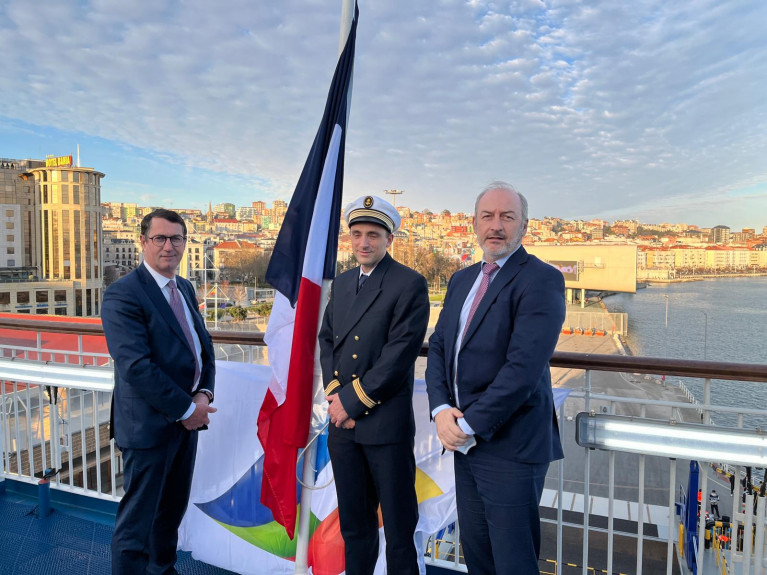Displaying items by tag: New Salamanca reflagged
Brittany Ferries newest and greenest ferry when in northern Spain at the Port of Santander saw an official raising ceremony of the French tricolor take place on board the Salamanca.
(The newbuild Afloat adds follows Stena RoRo's chartered in E-Flexers) that began with Galicia entering in 2020 and Santoña which will join the French fleet in 2023. All are powered by Liquefied Natural Gas (LPG).
Tuesday's ceremony on Salamanca, actually involved a reflagging as the red, white and blue of the French flag proudly replaced the flag of Cyprus under which the ferry sailed to Europe from its shipyard in China.
Salamanca's change of flag signifies that the ferry is now also officially registered in France, and part of the French merchant fleet with crew from the same nation.
The ship’s hull now bears not only the name of a Spanish town of arts and culture, Salamanca (Castilla y León). It also incudes, as does every Breton ferry in the company, that of Morlaix, the Finistère town where the ship is officially registered.
New national flagship for energy transition
Salamanca becomes one of nine ships to sail under the French flag for Brittany Ferries, the largest employer of French seafarers. Being registered in France means that French law applies on board the ship. It also requires the ship to comply with rigorous French rules and regulations relating to ownership, safety, security, environment, and crewing.
Salamanca is Brittany Ferries most green ship which runs on liquefied natural gas (LNG) and which emits virtually no sulphur dioxide, nitrogen dioxide or particulate emissions following combustion. In addition, because LNG burns more efficiently than diesel, there is a reduction in carbon dioxide (CO2) output of around 25 per cent. The newbuild is the leading French ferry in terms of energy transition: one of the largest, most modern and cleanest in the European Union.
Following drydocking, crew training and berthing trials, Salamanca will enter service on 27th March carrying passengers and freight on routes from Bilbao, Spain and Cherbourg to Portsmouth in the UK.
By 2025, five brand new vessels will have joined the company’s fleet.
As alluded above the Galicia entered service in 2020, followed by Salamanca in 2022 and the Santoña in 2023, both powered by Liquefied Natural Gas.
As Afloat also reported they will be joined by two LNG/electric hybrid vessels in 2024 and 2025.

























































